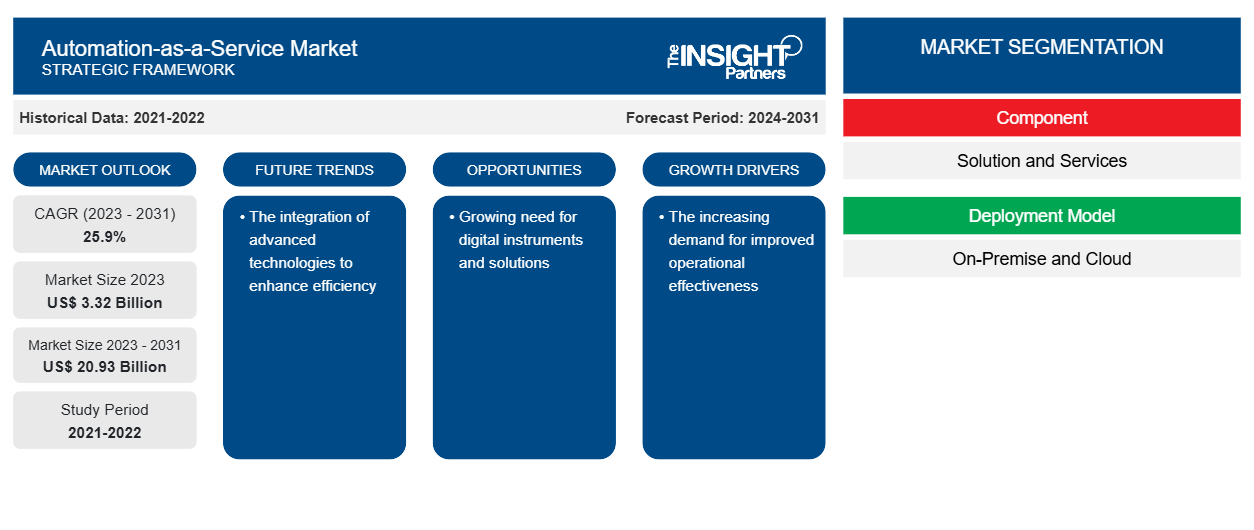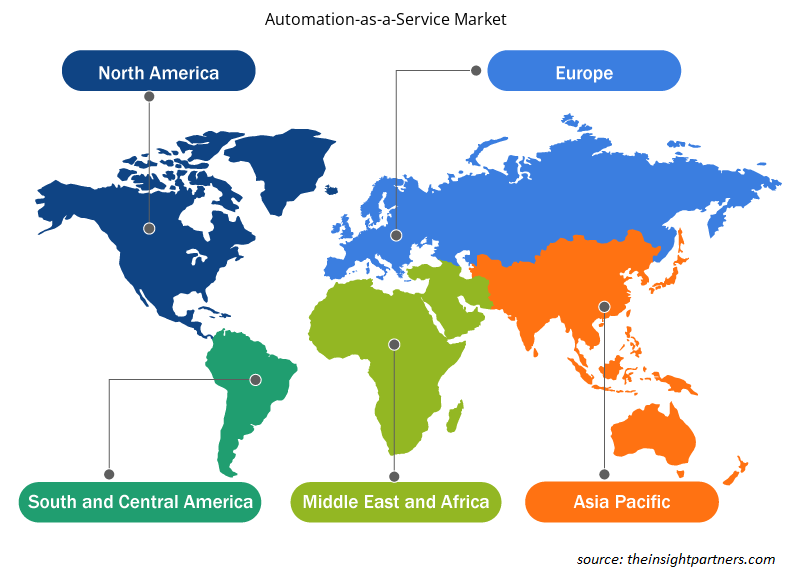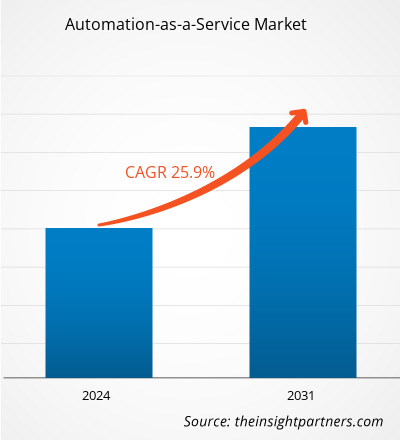The automation-as-a-service market size is projected to reach US$ 20.93 billion by 2031 from US$ 3.32 billion in 2023. The market is expected to register a CAGR of 25.9 % in 2023–2031. The integration of advanced technologies to improve efficiency is likely to remain a key automation-as-a-service market trend.
Automation-as-a-Service Market Analysis
The market is expanding rapidly due to the increasing use of AaaS, which enables businesses to increase their competitiveness, focus on higher-value tasks, and generate faster and more accurate outcomes. Furthermore, the market is being impacted by the increasing demand for AaaS, resulting in the global expansion of remote work culture. Aside from this, industry investors are being presented with profitable growth prospects through the increasing acceptance of AaaS, which can support sustainability initiatives by lowering paper waste, energy consumption, and carbon emissions through streamlined procedures. Furthermore, the increasing emphasis on improved security to combat cyberattacks is driving the market expansion. In keeping with this, the market is growing due to the increasing number of AaaS providers globally.
Automation-as-a-Service Market Overview
Through the automation of numerous tasks and workflows, Automation as a Service (AaaS) is a cloud-based solution that gives businesses the flexibility to optimize and streamline their processes. It uses cutting-edge technology to effectively manage time-consuming and repetitive operations across several departments and functions, including robotic process automation (RPA), machine learning (ML), and artificial intelligence (AI). In addition, it offers a scalable and affordable automation solution that enables businesses to do away with manual interventions, lower error rates, and boost output.
Customize This Report To Suit Your Requirement
You will get customization on any report - free of charge - including parts of this report, or country-level analysis, Excel Data pack, as well as avail great offers and discounts for start-ups & universities
Automation-as-a-Service Market: Strategic Insights

- Get Top Key Market Trends of this report.This FREE sample will include data analysis, ranging from market trends to estimates and forecasts.
You will get customization on any report - free of charge - including parts of this report, or country-level analysis, Excel Data pack, as well as avail great offers and discounts for start-ups & universities
Automation-as-a-Service Market: Strategic Insights

- Get Top Key Market Trends of this report.This FREE sample will include data analysis, ranging from market trends to estimates and forecasts.
Automation-as-a-Service Market Drivers and Opportunities
The increasing demand for improved operational effectiveness
The market is expanding as a result of the increasing use of AaaS, which can improve operational effectiveness and provide significant cost savings to a variety of industries. It also makes it simple to automate time-consuming and repetitive processes, which lessens the need for physical labor. This greatly speeds up task completion while simultaneously reducing human mistakes. Consequently, this allows firms to maximize the use of their resources, assign workers to more strategic projects, and eventually increase productivity. Aside from this, the pay-as-you-go or subscription model that AaaS solutions sometimes use avoids the need for significant upfront investments in software or equipment, which provides a positive market outlook. Advanced automation is accessible to companies of all sizes thanks to this economical method.
Growing need for digital instruments and solutions
The market is expanding as a result of the growing need for digital tools and solutions across several industries, which is driving the rising use of AaaS. Various businesses are implementing digital technology and updating their operations in accordance with this. They need products and services that can easily fit into their changing work processes. Aside from that, AaaS is a fantastic fit for this goal because it provides automation features that enhance digital activities. Furthermore, AaaS enables businesses to automate a range of functions, including supply chain management and customer support. This integration supports data-driven decision-making and boosts client experiences in addition to increasing efficiency. Thus, the increasing adoption of IoT is anticipated to present new opportunities for the automation-as-a-service market players during the forecast period.
Automation-as-a-Service Market Report Segmentation Analysis
Key segments that contributed to the derivation of the automation-as-a-service market analysis are component, deployment model, business function, and industry vertical.
- Based on the component, the automation-as-a-service market is segmented into solution and services.
- By deployment model, the market is segmented into on-premise and cloud. The Cloud segment held a larger market share in 2023.
- Based on the business function, the automation-as-a-service market is segmented into sales & marketing, finance & operations, human resources, and information technology.
- Based on the industry vertical, the automation-as-a-service market is segmented into BFSI, IT & telecom, retail, healthcare & life sciences, transportation & logistics, government agencies & defense, manufacturing, industry vertical, and others.
Automation-as-a-Service Market Share Analysis by Geography
The geographic scope of the automation-as-a-service market report is mainly divided into five regions: North America, Asia Pacific, Europe, Middle East & Africa, and South America/South & Central America. In terms of revenue, North America accounted for the largest automation-as-a-service market share. The region's market is expanding thanks to the growing use of automation, especially in sectors like healthcare and banking. Aside from this, a favorable market outlook is being provided by the increasing need for businesses to simplify operations and save expenses. Accordingly, the growing demand for data security is fueling the market's expansion in the North American region.
Automation-as-a-Service Market Regional Insights
The regional trends and factors influencing the Automation-as-a-Service Market throughout the forecast period have been thoroughly explained by the analysts at The Insight Partners. This section also discusses Automation-as-a-Service Market segments and geography across North America, Europe, Asia Pacific, Middle East and Africa, and South and Central America.

- Get the Regional Specific Data for Automation-as-a-Service Market
Automation-as-a-Service Market Report Scope
| Report Attribute | Details |
|---|---|
| Market size in 2023 | US$ 3.32 Billion |
| Market Size by 2031 | US$ 20.93 Billion |
| Global CAGR (2023 - 2031) | 25.9% |
| Historical Data | 2021-2022 |
| Forecast period | 2024-2031 |
| Segments Covered |
By Component
|
| Regions and Countries Covered | North America
|
| Market leaders and key company profiles |
Automation-as-a-Service Market Players Density: Understanding Its Impact on Business Dynamics
The Automation-as-a-Service Market is growing rapidly, driven by increasing end-user demand due to factors such as evolving consumer preferences, technological advancements, and greater awareness of the product's benefits. As demand rises, businesses are expanding their offerings, innovating to meet consumer needs, and capitalizing on emerging trends, which further fuels market growth.
Market players density refers to the distribution of firms or companies operating within a particular market or industry. It indicates how many competitors (market players) are present in a given market space relative to its size or total market value.
Major Companies operating in the Automation-as-a-Service Market are:
- Accenture PLC
- Automation Anyvvhere, Inc
- Blue Prism Group plc
- HCL Technologies Limited
- Hewlett Packard Enterprise
- IBM Corporation
Disclaimer: The companies listed above are not ranked in any particular order.

- Get the Automation-as-a-Service Market top key players overview
Automation-as-a-Service Market News and Recent Developments
The automation-as-a-service market is evaluated by gathering qualitative and quantitative data post primary and secondary research, which includes important corporate publications, association data, and databases. The following is a list of developments in the market for speech and language disorders and strategies:
- In Jan 2024, Automation Anywhere announced a suite of new benchmarking services and a new customer benchmarking database initiative to help companies assess and maximize the business value of process automation deployments. These offerings will help companies see what “best of breed” automation in their industry looks like and guide them towards the highest value automation priorities faster than they could have determined on their own.. (Source: Automation Anywhere, Press Release)
- In March 2022, Unit4, a leader in enterprise cloud applications for people-centric organizations, announced the launch of Smart Automation Services, which will enable its customers to leverage artificial intelligence and context awareness capabilities to improve efficiency and productivity. These services will integrate with Unit4’s next generation enterprise resource planning suite, ERPx, and its virtual assistant, to further streamline business processes. Leveraging these services, ERPx can automate a significant proportion of tasks and enable an optimized, customized, light-touch user experience. (Source: Unit4, Press Release)
Automation-as-a-Service Market Report Coverage and Deliverables
The “Automation-as-a-Service Market Size and Forecast (2023–2031)” report provides a detailed analysis of the market covering below areas:
- Market size and forecast at global, regional, and country levels for all the key market segments covered under the scope
- Market dynamics such as drivers, restraints, and key opportunities
- Key future trends
- Detailed PEST/Porter’s Five Forces and SWOT analysis
- Global and regional market analysis covering key market trends, major players, regulations, and recent market developments
- Industry landscape and competition analysis covering market concentration, heat map analysis, prominent players, and recent developments
- Detailed company profiles
Frequently Asked Questions
What is the estimated market size for the global automation-as-a-service market in 2023?
The global automation-as-a-service market was estimated to be US$ 3.32 billion in 2023 and is expected to grow at a CAGR of 25.9 % during the forecast period 2023 - 2031.
What are the driving factors impacting the global automation-as-a-service market?
The increasing demand for improved operational effectiveness and the growing need for digital instruments and solutions are the major factors that propel the global automation-as-a-service market.
What are the future trends of the global automation-as-a-service market?
The integration of advanced technologies to improve efficiency is anticipated to play a significant role in the global automation-as-a-service market in the coming years.
Which are the key players holding the major market share of the global automation-as-a-service market?
The key players holding majority shares in the global automation-as-a-service market are Accenture PLC, Automation Anyvvhere, Inc., Blue Prism Group plc, HCL Technologies Limited, and Hewlett Packard Enterprise.
What will be the market size of the global automation-as-a-service market by 2031?
The global automation-as-a-service market is expected to reach US$ 20.93 billion by 2031.
- Historical Analysis (2 Years), Base Year, Forecast (7 Years) with CAGR
- PEST and SWOT Analysis
- Market Size Value / Volume - Global, Regional, Country
- Industry and Competitive Landscape
- Excel Dataset
- Parking Meter Apps Market
- eSIM Market
- Advanced Distributed Management System Market
- Online Exam Proctoring Market
- Electronic Data Interchange Market
- Barcode Software Market
- Maritime Analytics Market
- Cloud Manufacturing Execution System (MES) Market
- Robotic Process Automation Market
- Digital Signature Market
Testimonials
Reason to Buy
- Informed Decision-Making
- Understanding Market Dynamics
- Competitive Analysis
- Identifying Emerging Markets
- Customer Insights
- Market Forecasts
- Risk Mitigation
- Boosting Operational Efficiency
- Strategic Planning
- Investment Justification
- Tracking Industry Innovations
- Aligning with Regulatory Trends
Yes! We provide a free sample of the report, which includes Report Scope (Table of Contents), report structure, and selected insights to help you assess the value of the full report. Please click on the "Download Sample" button or contact us to receive your copy.
Absolutely — analyst assistance is part of the package. You can connect with our analyst post-purchase to clarify report insights, methodology or discuss how the findings apply to your business needs.
Once your order is successfully placed, you will receive a confirmation email along with your invoice.
• For published reports: You’ll receive access to the report within 4–6 working hours via a secured email sent to your email.
• For upcoming reports: Your order will be recorded as a pre-booking. Our team will share the estimated release date and keep you informed of any updates. As soon as the report is published, it will be delivered to your registered email.
We offer customization options to align the report with your specific objectives. Whether you need deeper insights into a particular region, industry segment, competitor analysis, or data cut, our research team can tailor the report accordingly. Please share your requirements with us, and we’ll be happy to provide a customized proposal or scope.
The report is available in either PDF format or as an Excel dataset, depending on the license you choose.
The PDF version provides the full analysis and visuals in a ready-to-read format. The Excel dataset includes all underlying data tables for easy manipulation and further analysis.
Please review the license options at checkout or contact us to confirm which formats are included with your purchase.
Our payment process is fully secure and PCI-DSS compliant.
We use trusted and encrypted payment gateways to ensure that all transactions are protected with industry-standard SSL encryption. Your payment details are never stored on our servers and are handled securely by certified third-party processors.
You can make your purchase with confidence, knowing your personal and financial information is safe with us.
Yes, we do offer special pricing for bulk purchases.
If you're interested in purchasing multiple reports, we’re happy to provide a customized bundle offer or volume-based discount tailored to your needs. Please contact our sales team with the list of reports you’re considering, and we’ll share a personalized quote.
Yes, absolutely.
Our team is available to help you make an informed decision. Whether you have questions about the report’s scope, methodology, customization options, or which license suits you best, we’re here to assist. Please reach out to us at sales@theinsightpartners.com, and one of our representatives will get in touch promptly.
Yes, a billing invoice will be automatically generated and sent to your registered email upon successful completion of your purchase.
If you need the invoice in a specific format or require additional details (such as company name, GST, or VAT information), feel free to contact us, and we’ll be happy to assist.
Yes, certainly.
If you encounter any difficulties accessing or receiving your report, our support team is ready to assist you. Simply reach out to us via email or live chat with your order information, and we’ll ensure the issue is resolved quickly so you can access your report without interruption.





















 Get Free Sample For
Get Free Sample For